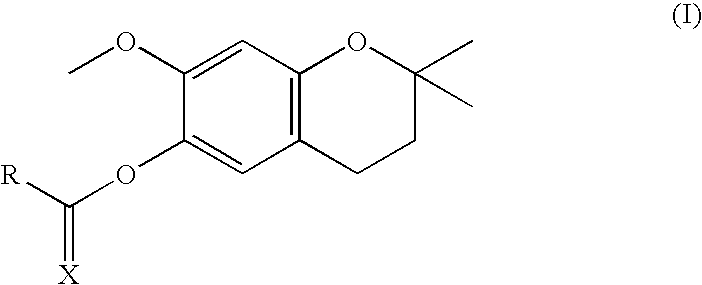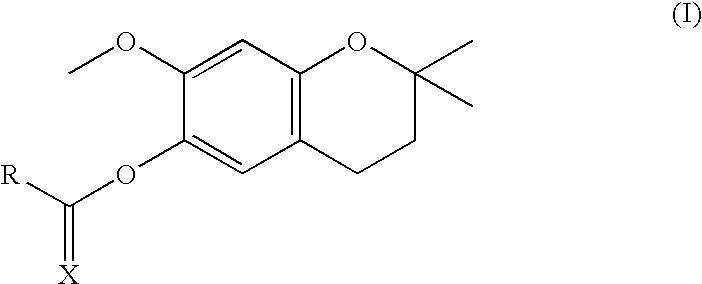Pigmentation-regulating compounds
a technology of pigmentation regulation and compounds, applied in the direction of antibacterial agents, antinoxious agents, drug compositions, etc., can solve the problems of cancerous hyperpigmentation lesions or melanomas, difficult and inability to achieve the effect of reducing the number of cancerous lesions or melanomas
- Summary
- Abstract
- Description
- Claims
- Application Information
AI Technical Summary
Benefits of technology
Problems solved by technology
Method used
Image
Examples
example 1
Preparation of 6-substituted 7-methoxy-2,2-dimethylchromanes
[0096]6-hydroxy-7-methoxy-2,2-dimethylchromane (5.0 g; 24.0 mmol, 1 equiv.) was reacted with 1 equiv. of the corresponding carboxylic or thiocarboxylic acid in the presence of DMAP (2.0 mmol, 0.083 equiv.) and DCC (24.0 mmol, 1 equiv.) in dichloromethane at room temperature, performing controls by thin layer chromatography. When it was observed that the reaction stopped progressing the formed dicyclohexylurea was filtered and evaporated to dryness. The obtained compounds were purified by silica column chromatography by eluting with n-hexane and ethyl acetate and were characterized by ESI-MS.
[0097]
Theoretical MWExperimental MWX = O264.32264.39R = CH3CH2—X = O306.40306.35R = CH3(CH2)4—X = O334.45334.40R = CH3(CH2)6—X = O348.48348.54R = CH3(CH2)7—X = O362.50362.48R = CH3(CH2)8—X = O376.53376.57R = CH3(CH2)9—X = O390.56390.51R = CH3(CH2)10—X = O418.61418.53R = CH3(CH2)12—X = O446.66446.62R = CH3(CH2)14—X = O474.72474.79R = CH3(...
example 2
Preparation of a Cosmetic Composition Containing 7-methoxy-6-palmitoyl-2,2-dimethylchromane
[0098]The following formulation was prepared as described in the present invention:
[0099]The components of Phase A were weighed in a large enough reactor and the mixture is heated to 70° C. to melt the waxes. The components of Phase B are weighed in a suitable container for the entire content. The components of Phase C are added to Phase B and heated to 70° C. under intense stirring. Then Phase A is slowly added to the preceding mixture under stirring and the mixture is maintained under stirring for 30 minutes at 70° C. It is left to cool under gentle stirring and when the mixture is at room temperature, xanthan gum and fragrance are added, the mixture is homogenized and the pH is corrected with triethanolamine if needed.
[0100]The cream that is obtained has a pH between 5.5 and 6.
[0101]
INGREDIENT (INCI Nomenclature)% BY WEIGHTPHASE AMINERAL OIL3.007-methoxy-6-palmitoyl-2,2-dimethylchromane0.10...
example 3
Preparation of Liposomes Containing 7-methoxy-6-palmitoyl-2,2-dimethylchromane
[0102]Dipalmitoylphosphatidylcholine (DPPC), cholesterol and 7-methoxy-6-palmitoyl-2,2-dimethylchromane are weighed and dissolved in chloroform. The solvent is evaporated under vacuum until obtaining a thin phospholipid layer, and this is hydrated by treating at 55° C. with an aqueous solution containing Phenonip®, obtaining the MLV liposomes. The ULV liposomes are obtained by submerging the MLV liposomes in an ultrasound bath at 55° C. for 8 2-minute cycles at 5 minute intervals. To reduce the size even more, it can be passed through an extrusion system under high pressure.
[0103]
INGREDIENT (INCI Nomenclature)% BY WEIGHTDIPALMITOYLPHOSPHATIDYLCHOLINE8.07-methoxy-6-palmitoyl-2,2-dimethylchromane1.0CHOLESTEROL3.0PHENOXYETHANOL, METHYLPARABEN,0.5ETHYLPARABEN, BUTYLPARABEN,PROPYLPARABEN, ISOBUTYLPARABENAQUA (WATER)87.5
PUM
| Property | Measurement | Unit |
|---|---|---|
| temperature | aaaaa | aaaaa |
| length | aaaaa | aaaaa |
| wavelength | aaaaa | aaaaa |
Abstract
Description
Claims
Application Information
 Login to View More
Login to View More - R&D
- Intellectual Property
- Life Sciences
- Materials
- Tech Scout
- Unparalleled Data Quality
- Higher Quality Content
- 60% Fewer Hallucinations
Browse by: Latest US Patents, China's latest patents, Technical Efficacy Thesaurus, Application Domain, Technology Topic, Popular Technical Reports.
© 2025 PatSnap. All rights reserved.Legal|Privacy policy|Modern Slavery Act Transparency Statement|Sitemap|About US| Contact US: help@patsnap.com



